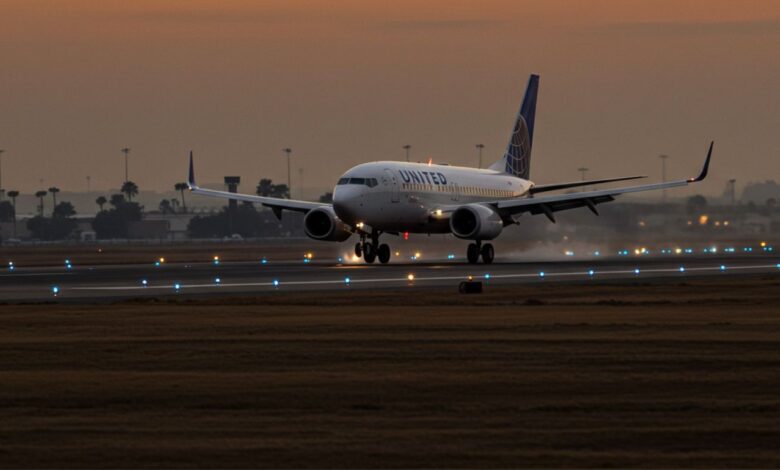United UA770 Emergency Diversion Lands Safely
United Airlines Flight UA770 Emergency Diversion

When passengers boarded United Airlines Flight UA770 from Barcelona to Chicago, few expected the journey would make headlines. Midway across the Atlantic, the flight experienced an unexpected technical warning related to cabin pressurization. This triggered a precautionary emergency diversion to London Heathrow, ensuring the safety of all passengers and crew.
The incident underscores how well-established aviation safety protocols work under pressure. Despite the drama, the outcome proved reassuring: no injuries, calm handling, and professional coordination between flight crew and ground teams.
Why United Airlines Flight UA770 Diverted
The decision to divert was prompted by an anomaly in the cabin pressurization system. Although no oxygen masks deployed and the cabin remained stable, the warning indicated a potential issue that could escalate at high altitude.
In aviation, precaution always outweighs risk. Pilots rely on strict procedures to protect lives, and the decision to declare an emergency was entirely consistent with international safety standards.
What Does “Emergency Diversion” Mean?
An emergency diversion refers to rerouting a flight to the nearest suitable airport when conditions onboard demand immediate attention. Reasons range from medical emergencies and technical faults to weather issues.
For UA770, the emergency diversion was a safety-first response. London Heathrow was chosen due to its strong infrastructure, technical capacity, and proximity to the flight’s path.
The Timeline of UA770 Emergency Diversion
The incident unfolded in stages:
-
Takeoff: UA770 left Barcelona smoothly for Chicago.
-
Cruising Altitude: Cabin pressurization sensors detected irregularities.
-
Emergency Declaration: The transponder was set to 7700, signaling emergency to air traffic control.
-
Diversion to Heathrow: The aircraft was rerouted to London, coordinated by ATC.
-
Safe Landing: UA770 landed without incident, escorted to a gate for inspection.
-
Passenger Support: Meals, accommodations, and rebooked flights were arranged.
Why Heathrow Was Chosen
London Heathrow wasn’t just the nearest large airport. It was ideal because:
-
It has emergency infrastructure for wide-body aircraft.
-
Maintenance teams and equipment are readily available.
-
Passenger facilities can accommodate international travelers.
-
Air traffic control experience ensures smooth handling.
This decision reduced risks and provided immediate technical and logistical support.
Passenger Experience During UA770 Diversion
For passengers, diversions can feel unsettling. However, reports indicated that the crew maintained clear communication, keeping travelers calm. The professionalism of both pilots and cabin staff helped reduce fear.
On arrival, passengers were met with support staff who offered refreshments, lodging if needed, and rebookings for onward journeys. While schedules were disrupted, the emphasis on safety provided reassurance.
Technical Background: Cabin Pressurization Issues
Aircraft cabins are pressurized to mimic conditions at around 6,000–8,000 feet above sea level, even while flying at 35,000 feet. This is maintained through air circulation systems, compressors, and sensors United UA770 Emergency Diversion Lands Safely.
If sensors detect irregularities, warning lights alert the cockpit. Even a minor malfunction can justify diversion since prolonged exposure to lower oxygen levels can cause headaches, dizziness, or in extreme cases, hypoxia.
The Significance of “Squawk 7700”
When UA770 declared an emergency, the pilots set their transponder to code 7700. This universal emergency signal informs all ATC centers that the flight requires priority handling.
This action does not necessarily indicate catastrophic failure—it simply ensures the aircraft receives immediate attention, faster routing, and dedicated landing clearance.
How Pilots Train for Such Emergencies
Pilots undergo repeated simulation training for pressurization problems. These drills prepare them to:
-
Recognize symptoms and warning signals.
-
Communicate with ATC clearly under stress.
-
Initiate emergency descent if required.
-
Make rapid decisions on diversion airports.
In UA770’s case, their preparation ensured a calm, structured, and safe response.
Crew and Airline Response
United Airlines has emphasized safety as its core value. After the safe landing, the airline ensured:
-
Engineers inspected the aircraft thoroughly.
-
Affected travelers were rebooked on new flights.
-
Customers received food, accommodations, and care.
This immediate assistance reflects how airlines minimize disruption after unexpected incidents.
Historical Context: Other United Diversions
UA770 joins a list of flights where emergency diversions showcased the resilience of aviation safety systems. Other notable cases include:
-
United Flight 328 (2021): Engine failure shortly after takeoff from Denver, landed safely.
-
United Flight 1175 (2018): Engine failure en route to Hawaii, no casualties.
In both cases, much like UA770, safety measures worked exactly as designed.
Lessons Learned from UA770
Several takeaways emerge from the UA770 emergency diversion:
-
Safety systems work best when used early.
-
Passenger communication is essential.
-
Training and preparedness save lives.
-
Airport infrastructure can make all the difference.Each incident strengthens future responses, ensuring aviation remains the safest mode of transport.
How Diversions Affect Travelers
While diversions cause delays, the priority is always passenger well-being. Airlines typically:
-
Rebook passengers on the next available flights.
-
Provide vouchers, food, and lodging.
-
Offer assistance for connecting flights and onward travel.
Though frustrating, diversions ultimately highlight airlines’ commitment to safety above all.
Aviation Industry Perspective
Experts often remind the public that diversions are signs of systems working properly, not failing. By addressing potential problems early, airlines prevent more serious consequences.
The UA770 incident adds to aviation’s impressive record: despite millions of flights annually, serious emergencies remain extremely rare United UA770 Emergency Diversion Lands Safely.
What Passengers Should Remember
For those concerned about similar incidents, here are key reminders:
-
Diversions are rare but expected safety measures.
-
Modern aircraft have multiple backup systems.
Passengers can feel reassured that aviation safety remains unmatched in transport.
Looking Ahead
Investigations into UA770’s pressurization alert will continue, with engineers reviewing data logs and system performance. Any findings may lead to maintenance updates or procedural refinements, strengthening safety further.
The aviation industry thrives on learning from incidents. Each event, no matter how minor, helps improve global air travel standards.
Conclusion
The United Airlines Flight UA770 emergency diversion is a reminder of aviation’s uncompromising approach to safety. A possible pressurization issue prompted a swift but calm diversion, ensuring no harm came to passengers.
While diversions may disrupt schedules, they highlight the professionalism of pilots, cabin crew, and ground staff. More importantly, they reassure the traveling public that safety remains the non-negotiable foundation of air travel.
The UA770 event, rather than diminishing trust, reinforces confidence in aviation’s ability to handle unexpected challenges with precision and care United UA770 Emergency Diversion Lands Safely.




